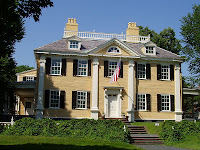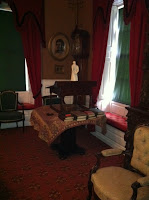Sometimes research for a book can take an author on a most interesting journey. Last week when I was in Boston my daughter, a librarian, told me about a series of brown bag poetry readings happening at the Longfellow House in Cambridge in honor of NationalPoetry Month (April) . She knew that I would be interested because the next installment of the M. J. Williams On the Road… series of mysteries takes place in Boston and the work of Henry Wadsworth Longfellow has a role it in. The focus for this year’s weekly readings was on the Fireside poets, contemporaries of Longfellow.
 |
| Longfellow House, Cambridge, MA |
So off I went to Cambridge with my lunch in a sack (kudos to Au Bon Pain) and an eager ear for poetry. The session was to be held in the Carriage House, as the main house was closed during the off season. But having the opportunity to see the inside of an 18th century carriage house that is bigger than the first home my hubby and I ever bought is something that strikes my fancy as being a good time (they actually had office cubbies set up in the reconditioned horse stalls).
About twenty people attended the poetry session this day, hosted by Park Ranger Rob Velella. Why would a National Park Ranger be hosting a poetry reading session at the Longfellow House in Cambridge, Massachusetts? Well, it turns out that the house, before Longfellow owned it, was the headquarters of General George Washington during the time of the Revolutionary War. And so besides being an icon of the literary set, it is also a National Park.
It also turns out that Ranger Rob is a literary historian. Besides having an excellent voice for the reading of mid-19th century poetry, he really knows his stuff when it comes to anything Longfellow. What I think I enjoyed most about the session was how, after reading the work of the featured poet, Rob opened it up to discussion. And being Cambridge, people really got into talking about the meaning of the poems, the beauty of words, and even the history behind it all.
The session opened with one of Longfellow’s poems, “Carillon” (from the Belfry of Burges and Other Poems, 1845). But the featured poet was actually William Cullen Bryant. Rob explained that the Fireside poets are not generally considered to have produced highly sophisticated works, but rather they wrote in a style intended for families to sit around the fireplace and read and enjoy. They were hugely popular and wrote about family life, nature, and populist politics.
The poems by Bryant that he chose for us were: “To a Waterfowl” (1821), “The Death of the Flowers” (1832), “The Future Life” (1842), “The Gladness of Nature” (1853), and “Dante” (1865).
The highlight of my afternoon however was when I had a chance to talk with Rob after the session was over and as the others were leaving. I told him I was from Wisconsin and that I’d never been inside the main house; I tend to make my trips to Boston in the off season. Rob immediately offered to give me private tour. And of course I accepted.
The house is amazing. It has been totally preserved with the very furnishings and possessions that belonged to Longfellow and his second wife Frances Appleton (who died tragically from burns sustained after her dress caught on fire melting wax to seal an envelope). Each room is set up exactly the way it was when the Longfellow lived there.
 |
| A corner of Longfellow’s den |
Rob, who was a veritable font of stories about Longfellow as he ushered me through the various rooms, called Longfellow’s den his “man cave.” And that was a pretty apt description. The poet’s den was the only room in the house that his wife left alone. He furnished it himself, and it is filled with personal memorabilia commemorating the “Dante Club,” the group of literati, who met with Longfellow on a weekly basis and critiqued his translation of the Dante’s Divine Comedy. (For a fun if rather violently graphic read, try Matthew Pearl’s period mystery TheDante Club; it’s fiction but based on historical research).
And lest you think being a 19th century poet could not have been a very lucrative occupation back then, think again. Oh yes, Longfellow did have a day job. He was a professor at Harvard. But that salary could hardly have afforded him a house in the style of this one, much less the two next door that he had built and gifted to his daughters and the several across the street that he gave to various extended family members. It turns out that Henry Wadsworth Longfellow ( “Paul Revere’s Ride,” The Song of Hiawatha, Evangeline) was pretty much the James Patterson of his day.
 |
| Garden at Longfellow House |
If you get out to Boston, I recommend taking the time to visit the Longfellow House. The neighborhood alone is worth walking through. The houses are old and grand. And stepping inside the big yellow edifice at 105 Brattle Street is definitely like taking a step back in time. Even if you’re not really into poetry.
My sincere gratitude and thanks to Rob Velella for taking the time to show me around the house, entertain me with stories of this eminent poet, and introduce me to some most wonderful poetry.

